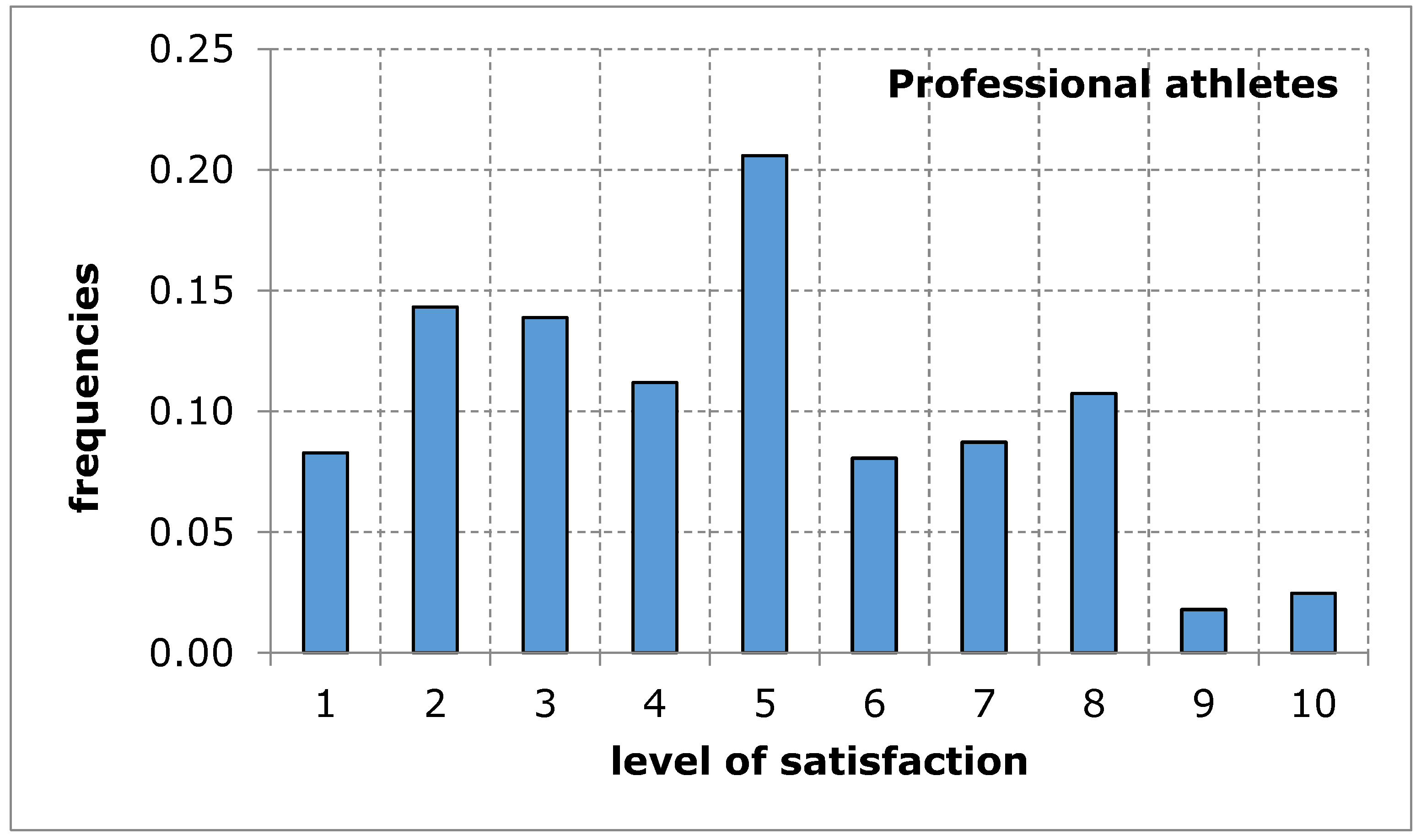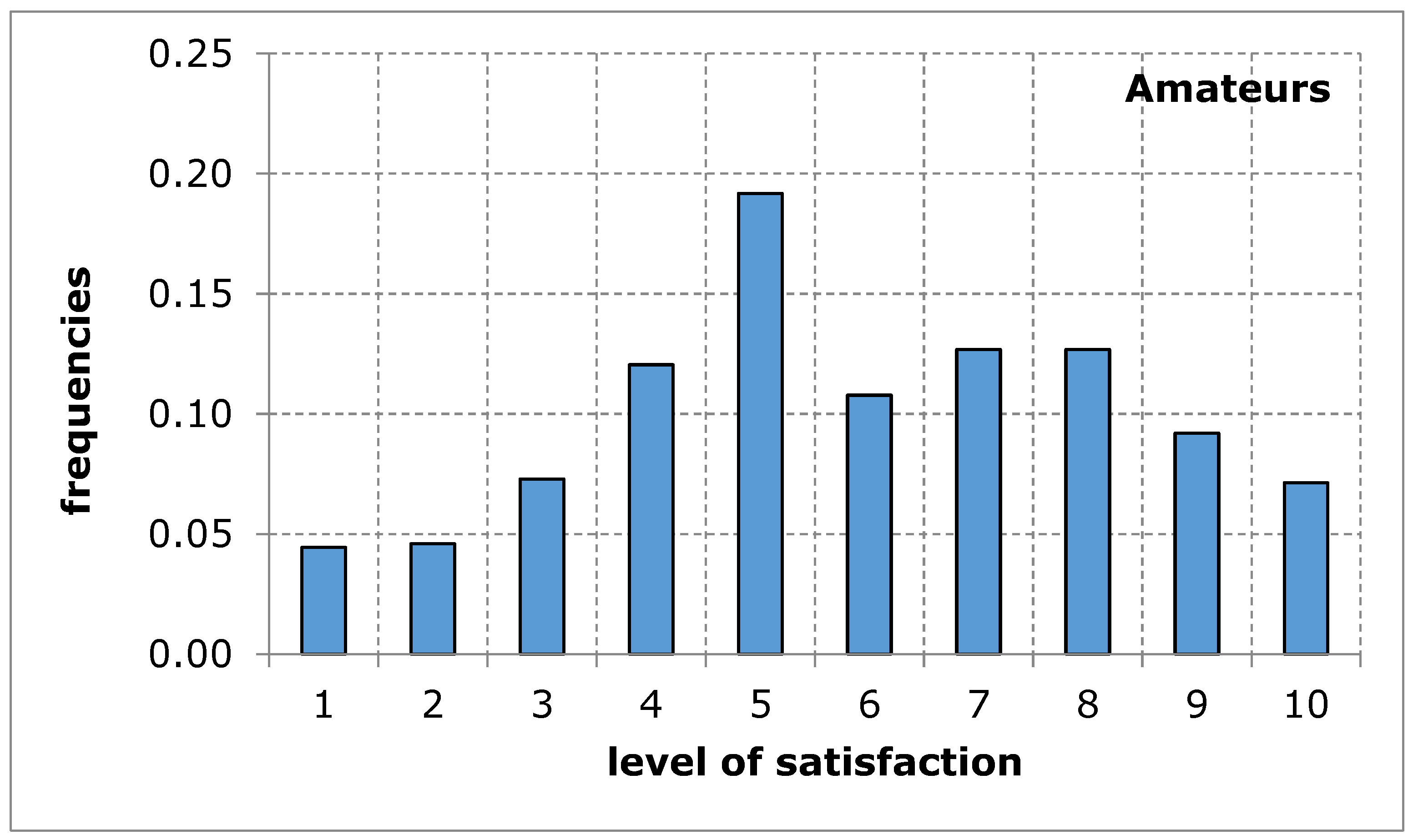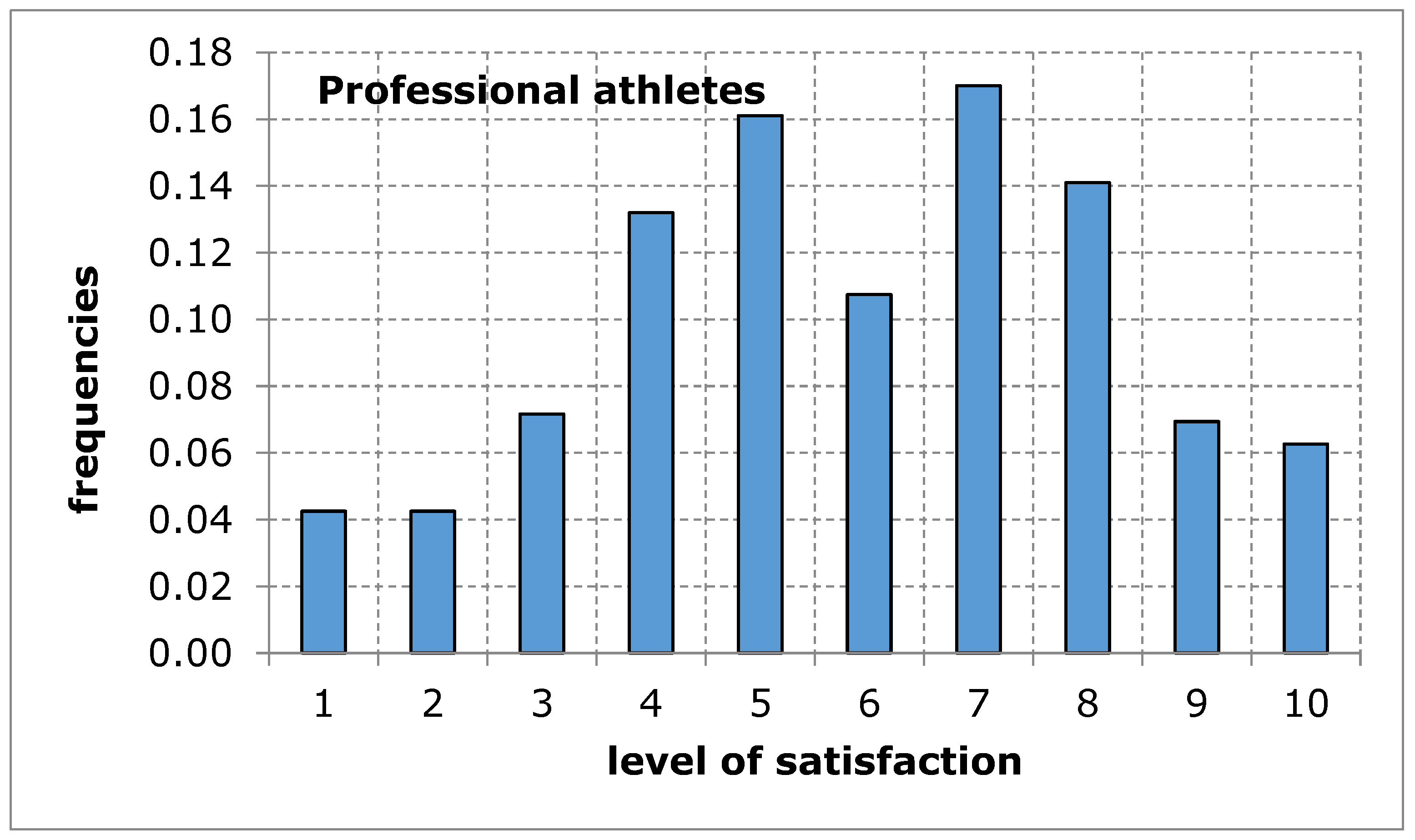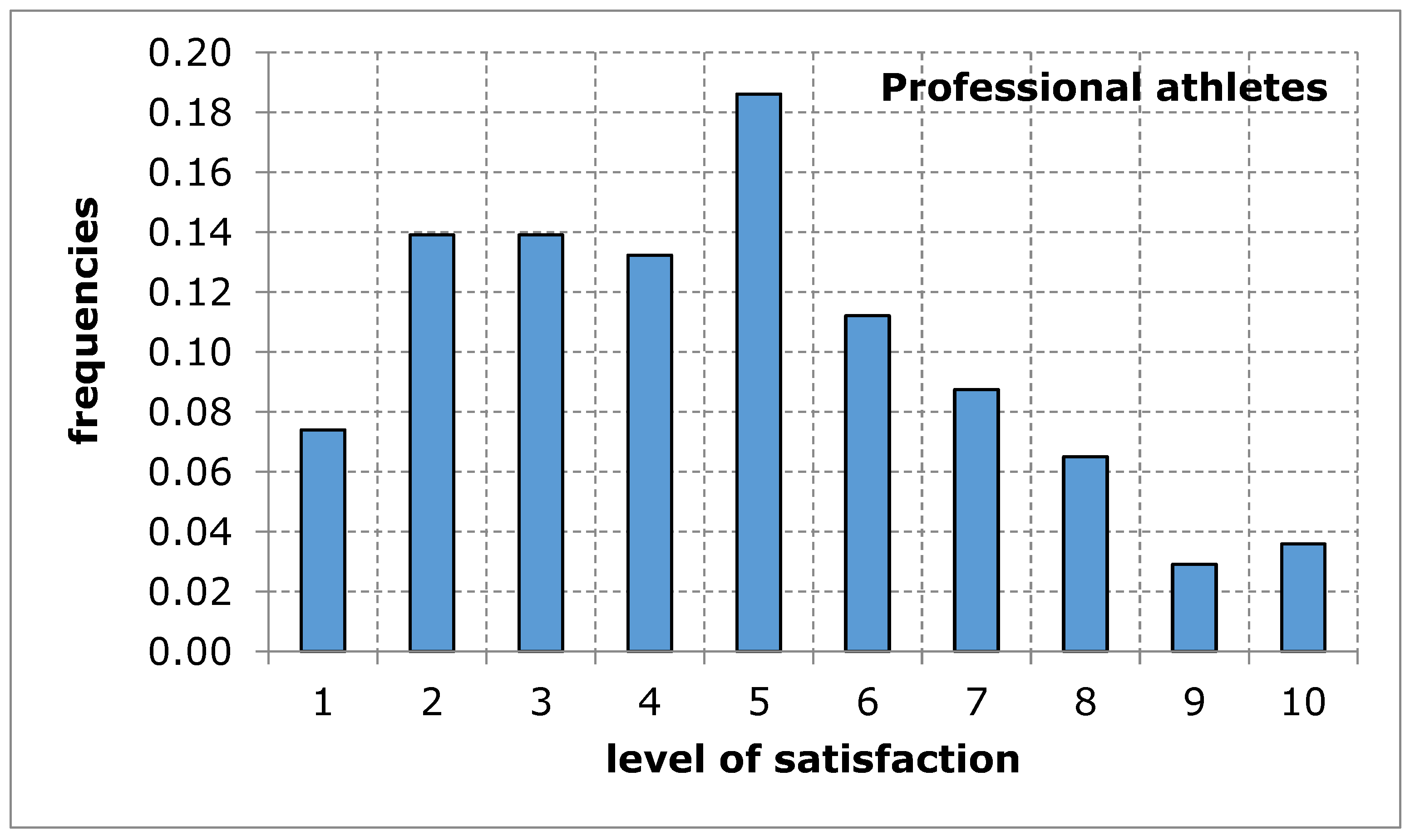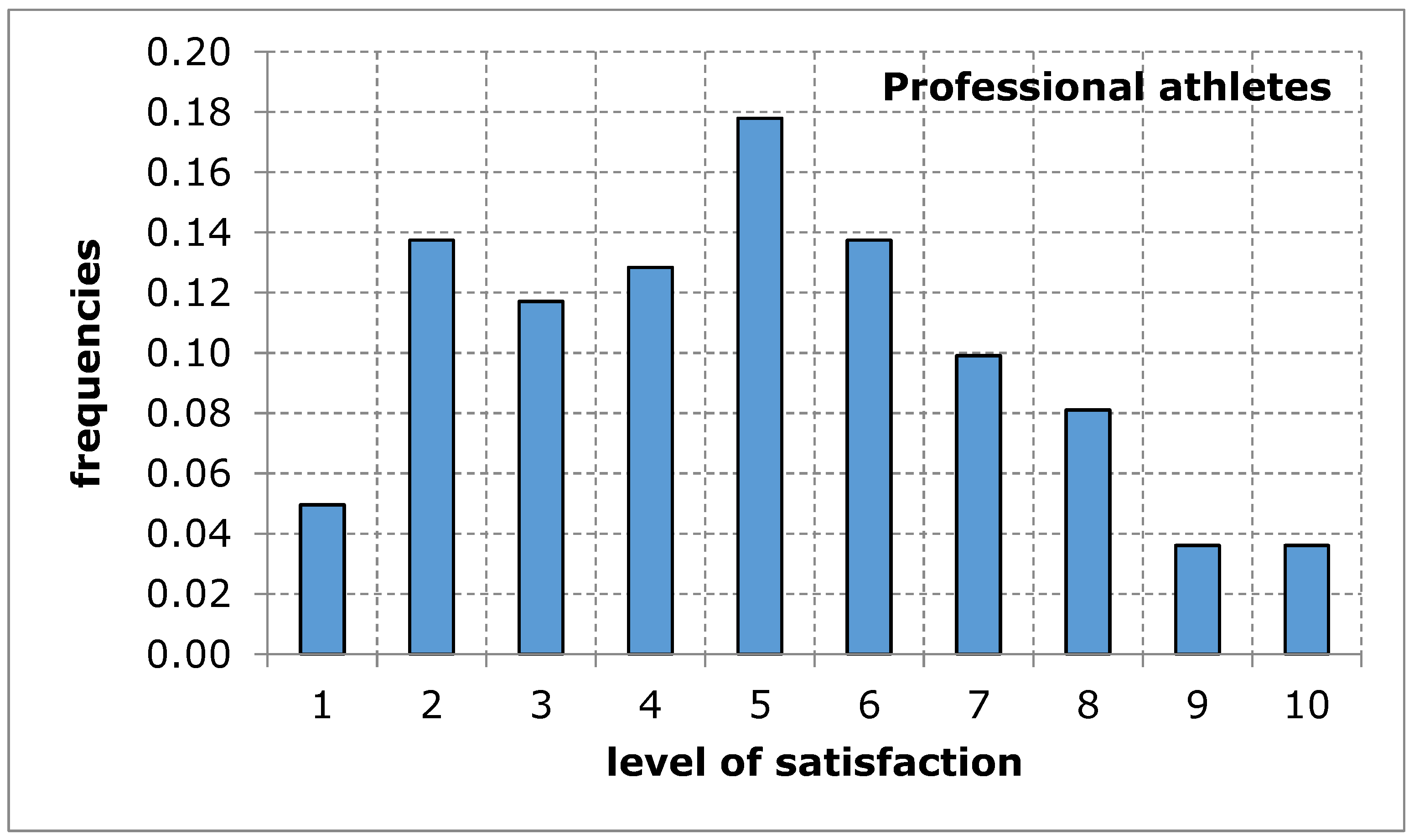1.1. Contemporary Premises for Undertaking Physical Activity
Freedom of choice, which characterizes free time activities, is often limited by the individual features of a person, financial potential, place of living and living conditions, a range of cultural activities and real availability [
1,
2,
3,
4]. In the modern world, one of the criteria for assessing quality of life is the organization of everyday life. A professionally active person gives special importance to free time, especially its quantity and forms of spending. They depend largely on preferred lifestyle. Representatives of various scientific disciplines—due to demographic processes, economic and socio-cultural tendencies—have paid more and more attention to the issue of free time, which is equated with recreation and leisure [
5,
6,
7,
8,
9,
10]. Leisure time considered from a social point of view is determined by several factors. First of all, there is the cultural level of society, whose height affects the creation of conditions for valuable forms, the organization and arrangement of recreation centers, cultural centers, artistic institutions, giving the opportunity for useful and valuable leisure time and a negative attitude towards primitive forms [
4]. Secondly, there is the factor of general access to the infrastructure of work centers, culture, sport, nutrition, etc., i.e., from communication conditions determining the budget of free time, as well as networks of commercial, service, cultural and recreational centers [
4,
6]. Separate factors affecting people’s free time are environmental factors, which include: the degree of concentration of the population (the greater, the better conditions for organizing free time), the occupational diversity of residents (the greater, the richer the range of needs related to free time), conditions material (the higher the level of economic development, the better the organization of leisure time institutions and institutions), the activities of social and cultural organizations (the intensity of organization of free time depends on the creativity and activity of social and cultural organizations), an adequate number of places, centers adapted to organize recreational activities, their equipment and preparation of instructors, the tradition of spending time in a given region, the rational urbanization of housing estates (parks, squares, proximity of the forest), the state of education, and upbringing [
11,
12,
13,
14,
15,
16,
17]. The tendencies of contemporary civilization specifically affirm health. It is recognized as an autotelic value that is important to every individual and to society as a whole. Health absolutely correlates with physical activity. The results of many studies suggest that in the majority of the examined youth, neither the family nor the school managed to instill the habit of spending free time actively [
17,
18,
19,
20].
According to many authors, health seems to be the most important motivating factor for participation in physical activity [
21,
22,
23,
24,
25]. Consistent physical activity is the way to maintain the physical functioning of the body and reduces risks for chronic diseases [
20]. Unfortunately, our care for health and well-being is definitely insufficient to maintain and improve basic health parameters [
26,
27]. This is the reason for the growing interest of specialists in many fields in the area of free time, regardless of age, gender or level of physical activity [
28,
29,
30], and the difficulties and barriers that contribute to the decline in physical activity of societies and the availability of sports and recreation infrastructure [
31,
32,
33,
34].
Mass media, mass sports and recreational events dedicated to amateur athletes play an important role in the process of health and active lifestyle promotion. It is an important element of the social policy of many countries, including Poland [
35,
36,
37,
38]. On the other hand, the assessment of the involvement of local authorities in creating conditions for physical activity of residents ranked Poland in last place [
39]. Poles are still the less active inhabitants of southern European countries (including Greece), compared to the inhabitants of Scandinavian countries, where the vast majority of citizens are active [
40]. On the other hand, a turn towards a healthy and active lifestyle has been observed in Poland for a long time. The manner of consumption and the chosen forms of physical activity are changing, among the physically active Poles [
41]. In this respect, Poles are heading towards western patterns [
35]. According to Eurobarometer, only 27% of citizens perform regular activities in Poland and this result puts the country in one of the lowest positions in the EU [
42]. According to a CBOS report, the main motive for undertaking sport by Poles is health (70%), followed by pleasure (61%) [
43].
The research conducted as part of Social Project 2012 in Poland, commissioned by the Ministry of Sport and Tourism, shows that there was observed a significant variation in the frequency of physical activity by the inhabitants of individual voivodeships. Its results show that only in two voivodeships, Greater Poland and Lower Silesia, was the share of active people (doing sport every day, or often) exceeded the share of the inactive [
44]. The analytical report Evaluation of the Social Benefits of Investment in Sport in Relation to the Costs Incurred carried out in 2016 by the Ministry of Sport and Tourism shows that young people are much more often active than the elderly. The level of activity and intensity decreases with age. In the 15–24 age group, the percentage of those with the lowest level of physical activity is 38%, whereas in the 55–64 age group, it is 72%; it is 95% in the 75–84 age group. On the other hand, the physically inactive are 24%, 61% and 91% of respondents, respectively. Similarly, the percentage of those with the highest level of physical activity decreases with age. Among those aged 15–24, they constitute 39% of the population, while in the 55–64 age group they account for 12%. In addition to age, another factor significantly differentiating the level of physical activity is education, where it can be observed that the percentage of physically active in the group with higher education is higher and amounts to 53%. The average time devoted to physical activity is 2 h and 50 min weekly [
40]. These data are confirmed by the CBOS report The Physical Activity of Poles published by Małgorzata Omyła-Rudzka in 2013 [
43]. The favorite disciplines of Poles are running (33% of the physically active), swimming (29%) and cycling (53%) [
45], and the last two disciplines require special facilities to participate in.
1.2. Factors Limiting Access to Physical Activity
The benefits of regular physical activity help to improve overall health and fitness, maintain a healthy weight, reduce the risk for many chronic diseases and premature mortality and promote good mental health [
46,
47,
48]. Unfortunately, people experience a variety of personal and environmental barriers to engaging in regular physical activity. The most common reasons that adults do not adopt more physically active lifestyles are cited as [
49,
50,
51]: insufficient time to exercise, inconvenience of exercise, lack of self-motivation, non-enjoyment of exercise, boredom with exercise, lack of confidence in their ability to be physically active (low self-efficacy), fear of being injured or having been injured recently, lack of self-management skills (such as the ability to set, monitor, progress toward, or reward progress toward personal goals); lack of encouragement, support, or companionship from family and friends; non-availability of parks, sidewalks, bicycle trails, or safe and pleasant walking paths close to home or the workplace. According to Manaf, the top three barriers to engaging in physical activity across the adult lifespan are [
51]: time, lack of energy and motivation. Authors dealing with the issue of barriers in undertaking physical activity list such factors as [
52,
53,
54,
55,
56,
57,
58,
59,
60]: demographic, health-related, behavioral, cognitive, psychological, social and environmental (see
Table 1).
It is obvious that the environment in which we live has a great influence on our level of physical activity [
19,
58], and many factors including the accessibility of walking paths, cycling trails, and recreation facilities affect us. Factors such as traffic, availability of public transportation, crime, and pollution may also have an influence on quality of life. Factors including the social environment, such as support from family and friends, and community spirit are also important [
57,
61]. Some of the barriers to physical activity that people face include family responsibilities, as well as cultural or social beliefs, economic or employment status, level of education, lack of time, lack of motivation, lack of energy, lack of money, health conditions, parenting demands, gender stereotyping, limited mobility and cultural expectations, which may restrict the participation of (especially) women in certain forms of physical activity [
20,
61,
62,
63,
64,
65,
66,
67].
Therefore, an attempt was made to analyze the causes for the low level of physical activity in the society, as its importance to health has been recognized. Attention was paid to what main barriers in undertaking physical activity were indicated by respondents in surveys conducted in Europe by the Eurobarometer, in Poland by the Central Statistical Office (GUS), and in Poznan by means of our own research. The basic reason for failing to undertake physical activities is the time deficit—the majority of Poles justify their low physical activity with the lack of free time. However, as Kocemba [
68] has noted, indicating the lack of time as an objective obstacle to participate in physical culture is a classic rationalization of views and the concealment of more authentic reasons for preferring another type of activity. Another constraint that hinders regular physical activity is poor health, illness or disability, which often precludes from doing sports. Furthermore, research indicates reluctance of some people to undertake any types of exercise [
42]. The Eurobarometer results from 2017 show that 39% of surveyed Poles admitted that they were not interested in being physically active and that they would like to engage in other forms of activity. The results also underlined that infrastructure plays an important role in taking up regular sport activities—insufficiently developed sports facilities and lack of access to sports and recreation facilities is a barrier that is especially prominent in rural areas. Moreover, socio-economic limitations and high costs of participation in some forms of activity are indicated. As a result, some of the facilities are available only to people with relatively high incomes. On the other hand, it should be noted that the majority of people who declare exercising on a regular basis do it outdoors, in parks. Furthermore, more than half of the respondents of Eurobarometer in 2017 agreed with the statement that in their place of residence the conditions necessary for doing sports are provided [
42]. The argument about the lack of adequate access to infrastructure or high costs of using sports facilities and equipment is not always justified.
Poznan is a city located in West-Central Poland. The city’s population is about 540,000. It is an important academic site (with about 140,000 students), a center of trade, sports, technology, and tourism. It has often topped rankings as a city with very high-quality education and a very high standard of living [
69]. It also ranks highly in safety and quality of healthcare [
70]. Sports and recreation are important areas of activity for the city. Each year, more than 10% of Poznan’s budget is spent on physical culture, which is a level comparable to that of the European Union average [
71]. Poznan’s expenditures allocated to physical culture are the highest in the country and account for PLN 410 million, which is 12.3% of the annual budget of the city. Only Warsaw, which also allocates PLN 410 million a year for this purpose, can compete with Poznan, but this amount is only 3.3% of the capital’s budget [
72]. Poznan undoubtedly strives to be a city that “puts on sport”. In the resolution of the City Council adopted in 2010, “Strategy for the City of Poznan until 2030,” one of the strategic goals is to increase the importance of the city as a center of sport. Poznan has over 500,000 residents [
72]. The sports and recreation infrastructure is very complex because it consists of various elements, from huge recreational complexes to modern large-area clubs to intimate places associated with the chosen form of recreation. The diverse offer of sports and recreation facilities proposed by the city for its residents undoubtedly translates into a better image for these places. That is, the residents’ perception of the territorial unit and opinion of it is more likely to be positive [
72].





